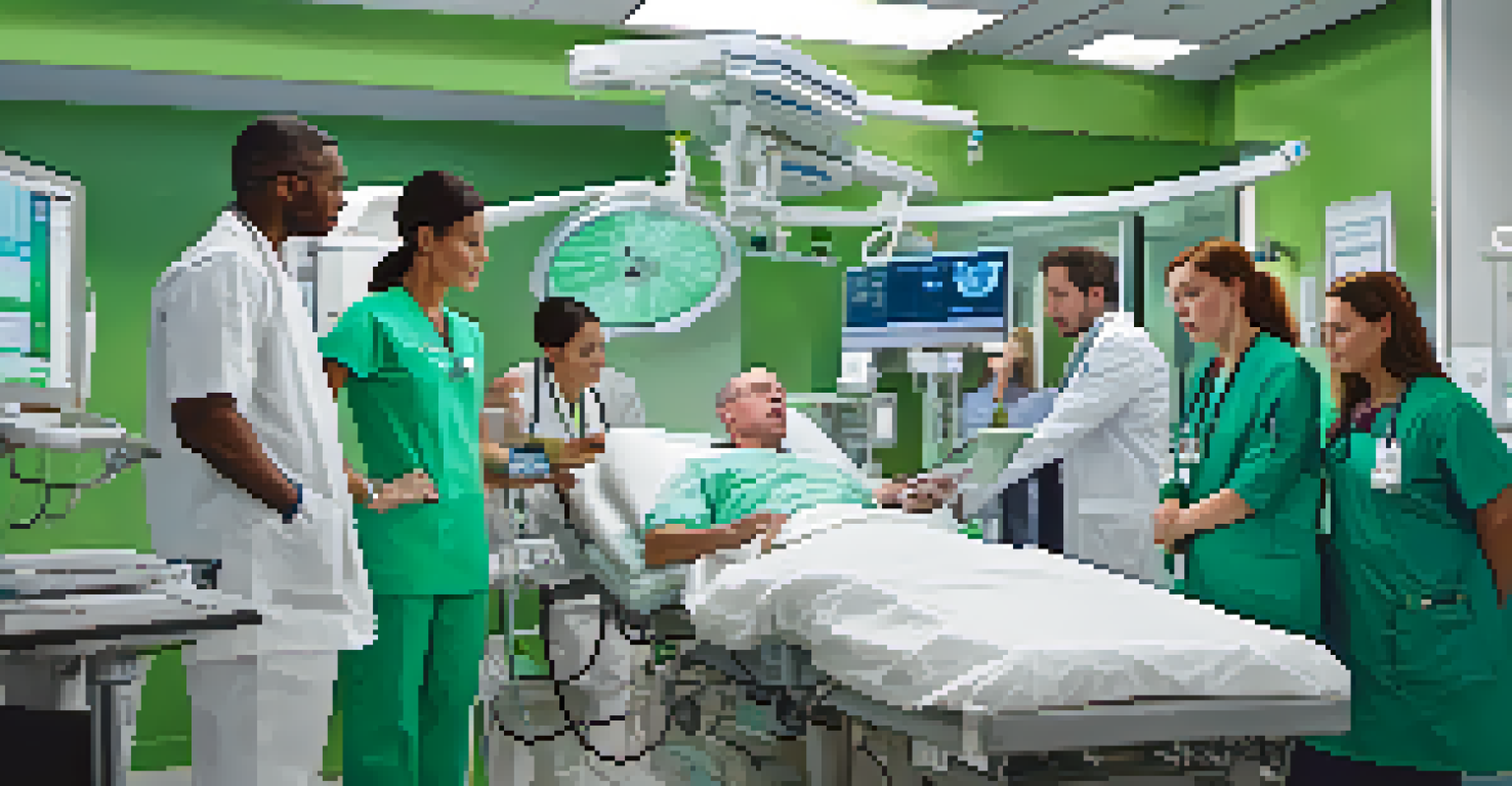Common Conditions Treated in Emergency Medicine Departments

Understanding Chest Pain: A Common Emergency Complaint
Chest pain is one of the most frequent reasons patients visit emergency departments. It can stem from a variety of causes, including heart-related issues, gastrointestinal problems, or even anxiety. The urgency of addressing chest pain lies in the potential for life-threatening conditions, such as a heart attack, which requires immediate evaluation and treatment.
The greatest wealth is health.
When a patient presents with chest pain, emergency physicians perform a series of tests, including EKGs and blood tests, to determine the underlying cause. This comprehensive approach ensures that serious conditions aren’t overlooked. Moreover, doctors often ask about the pain's nature, duration, and accompanying symptoms to guide their diagnosis effectively.
It's crucial for patients experiencing chest pain to seek emergency care promptly. Quick action can be lifesaving, especially if the pain is related to a heart condition. Remember, it's always better to be safe and get checked out than to ignore potential warning signs.
Dealing with Abdominal Pain: A Frequent Emergency Visit
Abdominal pain is another common reason people rush to emergency departments. The causes can range from mild issues like gas and indigestion to more severe conditions such as appendicitis or pancreatitis. Because of this wide spectrum, doctors take abdominal pain seriously, often conducting thorough examinations.

During the evaluation, healthcare providers will ask about the pain's location, intensity, and any associated symptoms, like nausea or fever. Imaging tests, such as ultrasounds or CT scans, may also be utilized to pinpoint the issue. This process helps ensure that critical conditions are identified quickly and treated appropriately.
Chest Pain Requires Immediate Care
Prompt evaluation of chest pain is crucial as it can indicate life-threatening conditions like heart attacks.
For patients, understanding that abdominal pain can indicate something serious is essential. If the pain is severe or persistent, it’s crucial to seek immediate medical attention to rule out any significant health risks.
Managing Cuts and Lacerations in Emergency Settings
Cuts and lacerations are frequent injuries that bring people to the emergency room. Whether from a kitchen accident or a sports-related mishap, these injuries can vary significantly in severity. Emergency medicine teams are well-equipped to assess and treat these wounds effectively.
In emergencies, every second counts.
Initially, the healthcare provider will clean the wound thoroughly to prevent infection. Depending on the depth and location of the cut, stitches or adhesive strips may be necessary to promote healing. Pain management and follow-up care instructions are also provided to ensure optimal recovery.
While minor cuts can often be treated at home, knowing when to seek emergency care is vital. If a cut is deep, won’t stop bleeding, or shows signs of infection, it’s essential to visit the nearest emergency department.
Addressing Respiratory Distress in Emergencies
Respiratory distress can be alarming, and it’s a common concern in emergency medicine. Patients may experience difficulty breathing due to conditions like asthma, pneumonia, or allergic reactions. Quick treatment is crucial, as inadequate oxygen can lead to serious complications.
Emergency physicians assess the severity of the respiratory issue by checking vital signs and oxygen levels. Treatments may include inhalers, oxygen therapy, or even intubation in critical cases. The goal is to stabilize the patient and address the underlying cause of their breathing difficulties.
Recognizing Stroke Symptoms Saves Lives
Identifying stroke symptoms early and acting fast can significantly improve recovery outcomes.
For individuals with known respiratory conditions, having an emergency plan can be life-saving. Recognizing early signs of distress and knowing when to seek help can make a significant difference in outcomes.
Head Injuries: A Critical Area of Emergency Medicine
Head injuries are a serious concern that often leads to emergency room visits. Whether from a fall, car accident, or sports injury, the implications can range from minor concussions to severe traumatic brain injuries. Medical professionals prioritize careful evaluation of these cases to assess the risk of complications.
In the emergency department, healthcare providers may perform neurological exams and imaging studies, such as CT scans, to determine the extent of the injury. Depending on the findings, treatment could involve monitoring, medication, or even surgery in severe cases. The primary focus is to ensure patient safety and prevent further harm.
If you or someone you know sustains a head injury, especially with symptoms like confusion or unconsciousness, seeking immediate medical attention is critical. Quick response can greatly affect the outcome.
Managing Allergic Reactions in Urgent Situations
Allergic reactions can escalate quickly, making them a common reason for emergency visits. Symptoms can vary from mild rashes to severe anaphylaxis, which is life-threatening and requires immediate intervention. Recognizing the signs early is key to effective management.
In the emergency department, healthcare providers assess the severity of the reaction and may administer medications like antihistamines or epinephrine. The goal is to alleviate symptoms and prevent further complications. Monitoring is essential, especially for patients experiencing anaphylaxis, as symptoms can recur.
Understanding Abdominal Pain Importance
Severe or persistent abdominal pain should be taken seriously, as it may signal critical health risks.
For those with known allergies, carrying an epinephrine auto-injector can be a lifesaver. Understanding how to use it and when to seek emergency care can make a significant difference during an allergic reaction.
Bone Fractures: Understanding Emergency Treatment
Bone fractures are a common occurrence in emergency medicine, often resulting from falls, sports injuries, or accidents. They can cause significant pain and limit mobility, making immediate care essential. Emergency departments are equipped to diagnose and treat fractures effectively.
Upon arrival, the medical team will perform a physical examination and may order X-rays to confirm the fracture and assess its severity. Treatment options range from splinting and casting to surgical intervention, depending on the type and location of the fracture. Pain management is also an essential part of care.

For individuals with suspected fractures, it’s crucial not to move the injured area excessively. Seeking timely medical attention can ensure proper healing and minimize complications.
Recognizing Stroke Symptoms: Quick Action is Vital
Strokes are medical emergencies that require immediate attention, making them a top priority in emergency medicine. Symptoms can include sudden numbness, difficulty speaking, or severe headaches. Recognizing these signs can be life-saving, as timely treatment can significantly improve outcomes.
Emergency medical teams utilize the acronym FAST—Face drooping, Arm weakness, Speech difficulties, and Time to call emergency services—to help identify potential strokes. Once at the hospital, rapid imaging tests and interventions are crucial to restore blood flow and minimize brain damage.
If you or someone else exhibits stroke symptoms, don’t hesitate to seek emergency help. The faster the response, the better the chances for recovery.